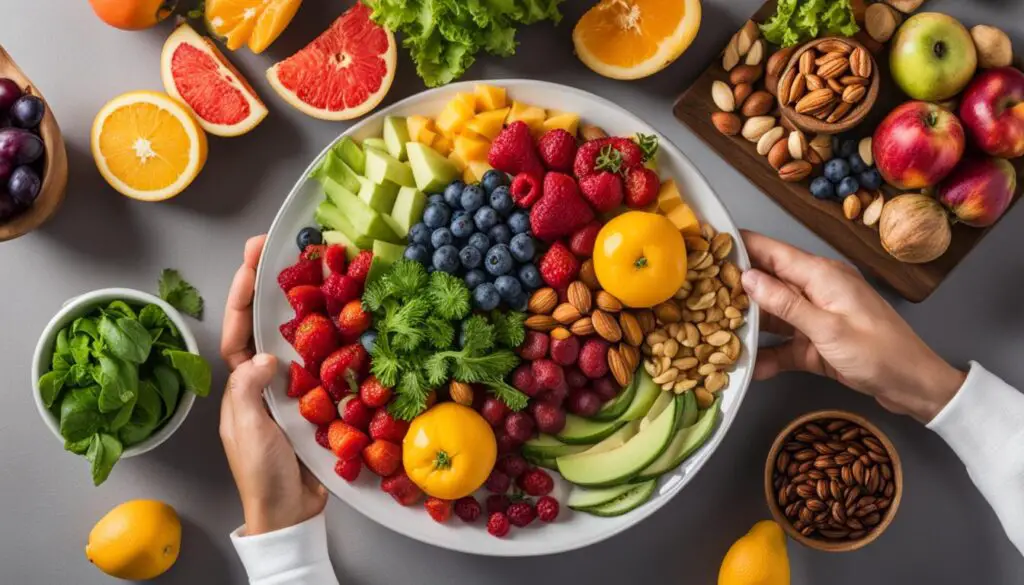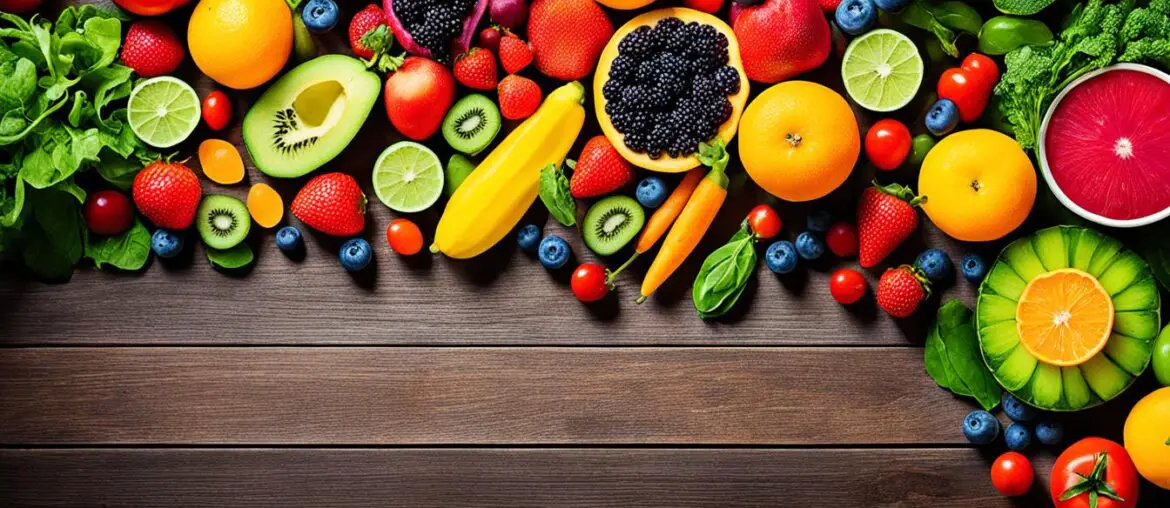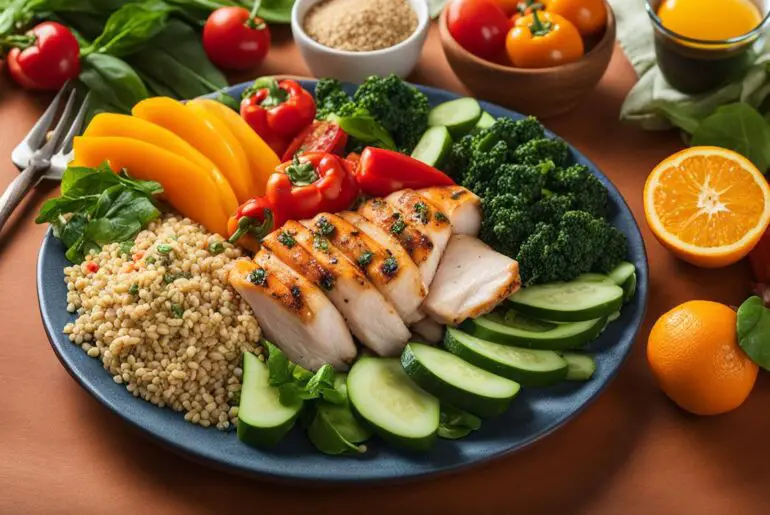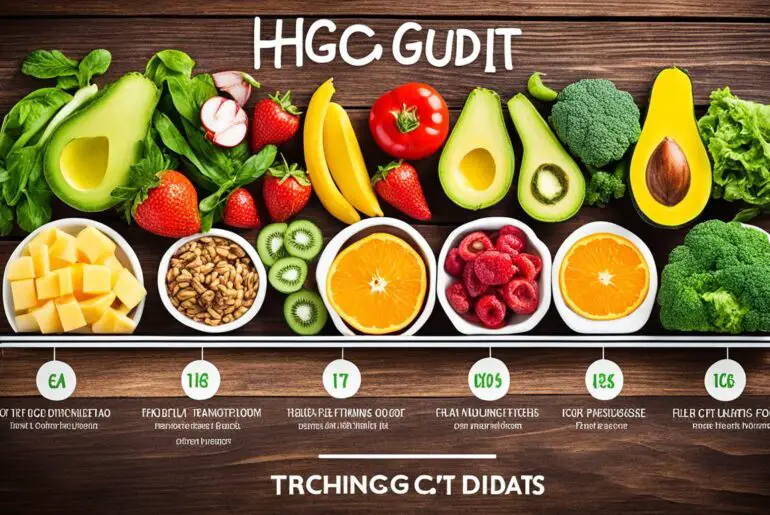Did you know that the Phase 3 of the HCG diet, also known as the Stabilization phase, is a critical period for maintaining weight loss and preventing weight regain? It’s a phase where dieters have the opportunity to expand their food choices while still following the principles of the HCG diet. By carefully selecting the right foods and following a structured plan, dieters can successfully stabilize their weight and establish healthy eating habits for long-term success.
Key Takeaways:
- Phase 3 of the HCG diet is crucial for maintaining weight loss and preventing weight regain.
- Expanding food choices during Phase 3 allows dieters to establish healthier eating habits.
- A structured plan can help dieters successfully stabilize their weight after the low-calorie diet phase.
- Reading food labels and understanding the science behind stabilizing are key components of Phase 3.
- Regular exercise and the proper interval between rounds are essential for long-term maintenance.
Understanding Phase 3 of the HCG Diet
Phase 3 of the HCG diet is a crucial transition period between the low-calorie diet phase and the maintenance phase. During this phase, dieters gradually increase their calorie intake while still being mindful of certain foods that can disrupt the stabilization process. The main goal of Phase 3 is to reset the hypothalamus and establish a new weight set point for long-term weight maintenance.
Transitioning to Phase 3 of the HCG diet requires careful adherence to the guidelines provided in the Phase 3 plan. These guidelines ensure that dieters prevent weight gain and successfully progress to the maintenance phase. By following the plan, dieters can achieve optimal results and maintain their weight loss without experiencing setbacks.
The transition from the low-calorie diet phase to Phase 3 involves a gradual increase in calorie intake. However, it’s important to note that certain foods should still be avoided during this phase to avoid disruptions in the stabilization process. By following the recommended guidelines, dieters ensure that they are making the right choices and setting themselves up for long-term success.
Resetting the hypothalamus is a key aspect of Phase 3. The hypothalamus is responsible for regulating hunger, metabolism, and other bodily functions. By establishing a new weight set point, dieters can maintain their weight loss and prevent the body from regaining the lost pounds.
Transitioning to Phase 3 of the HCG diet paves the way for successful weight maintenance. It allows the body to adjust to a higher calorie intake while still adhering to the principles of the diet. By following the guidelines provided in the Phase 3 plan, dieters can achieve long-lasting results and establish healthy habits for ongoing success.
The Importance of Phase 3 Food Choices

During Phase 3 of the HCG diet, the food choices you make play a crucial role in maintaining your weight loss and preventing weight regain. The Phase 3 plan developed by Russell and Ekberg provides guidelines to help you make informed decisions about what to eat during this important phase.
“The choices you make during Phase 3 can determine the success of your weight stabilization.”
In order to reduce stress on the hypothalamus and prevent over-indulgence in foods that can lead to weight gain, the Phase 3 plan emphasizes the avoidance of sugary foods, starches, grains, breads, nuts, beans, and most dairy products. By eliminating these food groups, you can maintain the metabolic balance achieved in the previous phases of the HCG diet and prevent any potential setbacks.
Expanding the Phase 3 Food List
The good news is that the Phase 3 plan also includes an expanded food list, giving you plenty of options to add variety to your meals. The list includes various choices for beverages, condiments, breakfast foods, appetizers, snacks, soups, salads, chicken, beef, fish, and seafood dishes.
“You won’t have to sacrifice taste or variety while staying on track with the HCG diet.”
Here’s an example of the expanded Phase 3 food list:
| Beverages | Condiments | Breakfast Foods |
|---|---|---|
| Morning tea with lemon | Mustard | Boiled eggs |
| Black coffee | Hot sauce | Vegetable scramble |
| Herbal tea | Vinegar | Smoked salmon |
And the list continues with options for appetizers, snacks, soups, salads, chicken, beef, fish, and seafood dishes. With such a wide range of choices, you can create delicious and satisfying meals that align with the Phase 3 guidelines.
“The expanded food list ensures that you never feel restricted while following the HCG diet.”
Tips for Reading Food Labels in Phase 3
During Phase 3 of the HCG diet, it is crucial to carefully read food labels to ensure that the foods you consume align with the guidelines and do not hinder your weight loss progress. Understanding how to read food labels effectively can help you make informed choices and stay on track with your Phase 3 journey. Here are some helpful tips to guide you:
- Scan the ingredients list: Begin by scanning the ingredients list to check for any hidden sugars, unhealthy fats, or high carbohydrate content. Be on the lookout for alternative names for sugar, such as fructose, corn syrup, or dextrose.
- Check the serving size: Pay attention to the serving size specified on the label, as this will determine the nutritional values provided. Adjust the values accordingly if you consume more or less than the serving size.
- Look for added preservatives and additives: Avoid foods that contain artificial preservatives, colors, or flavor enhancers, as they can disrupt your weight loss progress. Opt for whole, minimally processed foods whenever possible.
- Assess the macronutrient composition: Examine the macronutrient composition, including the amounts of carbohydrates, protein, and fat. Aim for a balance that aligns with the Phase 3 guidelines.
By following these tips, you can make informed choices when selecting foods, ensuring that they support your Phase 3 goals.
Expert Tip:
“Reading food labels is a valuable skill that empowers you to make healthier choices during Phase 3. Look for foods that are low in added sugars, unhealthy fats, and unnecessary additives. Remember, knowledge is power!”
Now that you have the knowledge of how to read food labels effectively, let’s move on to creating a Phase 3 meal plan. But before we dive into that, take a moment to check out this informative table on common food label terms and their meanings:
| Term | Meaning |
|---|---|
| Organic | Produced without synthetic fertilizers or pesticides |
| Low-fat | Contains 3 grams of fat or less per serving |
| Zero calories | Contains fewer than 5 calories per serving |
| Gluten-free | Does not contain gluten, a protein found in wheat, barley, and rye |
| Sodium-free | Contains less than 5 milligrams of sodium per serving |
| Whole grain | Contains all parts of the grain, including the bran, germ, and endosperm |
Use this table as a handy reference when deciphering food labels and making informed choices for your Phase 3 journey.
Creating a Phase 3 Meal Plan
A well-planned meal plan is crucial during Phase 3 to ensure that dieters consume a balanced diet while still adhering to the guidelines of the HCG diet. The Phase 3 plan provides a comprehensive 3-week food tracking guide, which can be used as a reference to create a customized meal plan based on individual preferences and dietary requirements.
By following the Phase 3 meal plan, dieters can enjoy a variety of delicious and satisfying meals while maintaining weight loss and stabilizing their metabolism. The meal plan includes a wide range of options, including:
| Beverages | Condiments | Breakfast Foods | Appetizers |
|---|---|---|---|
| Cucumber Lemon Water | Apple Cider Vinegar Dressing | Spinach and Mushroom Omelet | Caprese Skewers |
| Strawberry Lemonade | Homemade Salsa | Coconut Flour Pancakes | Stuffed Mushrooms |
| Snacks | Soups | Salads | Chicken Dishes |
| Spicy Roasted Chickpeas | Tomato Basil Soup | Grilled Chicken Caesar Salad | Lemon Garlic Chicken |
| Cauliflower Popcorn | Vegetable Soup | Caprese Salad | Buffalo Chicken Lettuce Wraps |
As dieters progress through Phase 3, they can experiment with different recipes and ingredients to add variety to their meals. The Phase 3 meal plan ensures that dieters have plenty of options to choose from, making it easier to stick to the diet and maintain long-term success.
With the Phase 3 meal plan, dieters can enjoy delicious and nutritious meals while still adhering to the principles of the HCG diet. By following the guidelines and incorporating the recommended recipes, dieters can set themselves up for success in maintaining their weight loss and transitioning to a healthy, sustainable lifestyle.
The Science Behind Stabilizing in Phase 3

During Phase 3 of the HCG diet, the focus shifts to stabilizing weight and maintaining the progress made in the previous phases. The Phase 3 plan developed by Sonia E. Russell and Candice Ekberg is rooted in the science of stabilizing weight after the low-calorie diet phase. By understanding the science behind this phase, dieters can effectively maintain their weight loss and avoid the need for additional rounds of the HCG diet.
The Phase 3 plan acknowledges the role of the hypothalamus, a small region in the brain that regulates hunger, metabolism, and body weight. By avoiding certain foods and providing the body with nutrient-dense options, the plan aims to reduce stress on the hypothalamus. This helps the body maintain a new weight set point and stabilize weight without the frustration of chronic correction days or weight regain.
To further support stabilization, the Phase 3 plan incorporates guidelines, food choices, and recipes that promote a nutrient-rich and balanced diet. By following these recommendations, dieters can ensure that their bodies are receiving the necessary nutrients while still adhering to the principles of the HCG diet.
This science-backed approach to stabilizing weight in Phase 3 sets dieters up for long-term success by promoting a sustainable and healthy lifestyle. With the understanding and implementation of the Phase 3 guidelines, dieters can confidently navigate this crucial phase and maintain their weight loss without compromising their overall well-being.
| Benefits of following the Phase 3 plan |
How it works |
|---|---|
| • Stabilizes weight • Prevents weight regain • Reduces stress on the hypothalamus |
• Avoids certain foods • Provides nutrient-dense options • Supports maintenance of a new weight set point |
| • Promotes long-term success • Encourages a healthy lifestyle |
• Establishes sustainable eating habits • Balances nutrients and adherence to HCG diet principles |
The science behind stabilizing in Phase 3 is the key to maintaining weight loss and transitioning to a lifelong healthy lifestyle. By understanding the role of the hypothalamus and following the Phase 3 plan, dieters can experience successful weight stabilization and avoid the frustration of setbacks or the need for additional rounds of the HCG diet.
Interval Between Rounds and Basal Metabolic Rates
When following the Phase 3 plan of the HCG diet, understanding the interval between rounds and basal metabolic rates is crucial for successful weight maintenance. The ideal interval between rounds allows the body to stabilize before starting another round of the diet. This gives your body the time it needs to adjust and maintain the weight loss achieved during the previous phase.
To determine the appropriate interval between rounds, it’s important to consider your individual basal metabolic rate (BMR). Your BMR is the number of calories your body needs to perform basic functions while at rest. By understanding your BMR, you can make informed decisions about calorie intake during Phase 3.
Basal metabolic rates vary from person to person, depending on factors such as age, gender, weight, and height. Several formulas can be used to estimate BMR, such as the Harris-Benedict equation. However, it’s best to consult with a healthcare professional or registered dietitian to determine your specific BMR and customize your Phase 3 plan accordingly.
Additionally, resting metabolic rates (RMR) also play a role in calorie intake during Phase 3. Your RMR is the number of calories your body needs to maintain weight while at rest, taking into account physical activity levels. It is essential to understand your RMR to avoid overeating or undereating during this crucial phase of the HCG diet.
By considering both the interval between rounds and your basal metabolic rates, you can make informed decisions about the duration of each phase and the appropriate calorie intake. This will help you maintain your weight loss, prevent weight regain, and achieve long-term success with the HCG diet.
Remember, the Phase 3 plan provides comprehensive guidance on these factors, helping you make informed choices about your diet and exercise routines. Taking the time to understand your body’s needs and adjust your plan accordingly will contribute to your overall success in maintaining your weight loss.
Basal Metabolic Rate Calculation Example:
Let’s calculate an example of basal metabolic rate (BMR) using the Harris-Benedict equation:
For a 35-year-old woman weighing 150 pounds and measuring 5 feet 6 inches tall:
Step 1: Convert weight to kilograms: 150 pounds x 0.4536 = 68.04 kilograms
Step 2: Convert height to centimeters: 5 feet 6 inches = 66 inches = 167.64 centimeters
Step 3: Calculate BMR using the formula:
BMR = 655 + (4.35 x weight in kg) + (4.7 x height in cm) – (4.7 x age)
| Age (years) | Weight (kg) | Height (cm) | BMR |
|---|---|---|---|
| 35 | 68.04 | 167.64 | 1474.47 |
In this example, the estimated basal metabolic rate for a 35-year-old woman weighing 150 pounds and measuring 5 feet 6 inches tall is approximately 1474.47 calories per day. This calculation can serve as a starting point to customize your Phase 3 plan based on your individual needs.
Stay tuned for the next section, where we will explore the role of exercise during Phase 3 of the HCG diet and how it contributes to weight maintenance and overall health.
Incorporating Exercise in Phase 3

During Phase 3 of the HCG diet, exercise is an essential component for both maintaining weight loss and promoting overall health. By incorporating regular physical activity into your daily routine, you can improve your metabolism, increase muscle tone, and support your well-being. The Phase 3 plan provides valuable recommendations and guidelines for incorporating exercise into your Phase 3 journey.
Exercise not only helps to burn calories but also plays a significant role in maintaining the weight loss achieved during the HCG diet. By engaging in both aerobic exercises and strength-training activities, you can enhance your fitness level and sustain your weight loss in the long term.
Types of Exercise to Consider:
- Aerobic Exercises: Incorporating activities such as walking, jogging, swimming, or cycling into your routine helps to elevate your heart rate and burn calories. Aim for at least 150 minutes of moderate-intensity aerobic exercise per week.
- Strength Training: Including strength-building exercises like weightlifting or resistance training helps to build lean muscle mass. This not only enhances your physique but also contributes to an increased metabolism.
It’s essential to find exercises that you enjoy and can commit to regularly. By choosing activities that bring you joy, you’re more likely to stick to your exercise routine and make it a sustainable habit during Phase 3. Remember, everyone’s fitness level and preferences are unique, so feel free to explore different exercises until you find what works best for you.
“Exercise is not only about burning calories; it’s about becoming a healthier, stronger version of yourself.” – Jane Smith (Certified Personal Trainer)
Benefits of Exercise during Phase 3:
Regular exercise during Phase 3 offers numerous benefits beyond weight maintenance:
| Benefits of Exercise | Why It’s Important |
|---|---|
| Boosts Metabolism | Regular physical activity helps increase your metabolic rate, allowing you to burn more calories even at rest. |
| Improves Mood | Exercise stimulates the release of endorphins, also known as feel-good hormones, promoting a positive mood and reducing stress. |
| Enhances Muscle Tone | Strength training exercises help sculpt and tone your muscles, providing a leaner and more defined appearance. |
| Increases Energy Levels | Regular physical activity boosts energy levels, allowing you to tackle your daily tasks with vigor and vitality. |
| Supports Overall Well-being | Exercise contributes to improved cardiovascular health, enhances flexibility and balance, and reduces the risk of chronic diseases. |
Remember to consult with your healthcare provider before beginning any exercise regimen, especially if you have any pre-existing health conditions or concerns. They can provide personalized recommendations based on your individual needs and ensure that you embark on a safe and effective fitness journey during Phase 3.
By incorporating exercise into your Phase 3 routine, you can maintain your weight loss, support your overall well-being, and continue to experience the benefits of a healthy and active lifestyle. Get moving and discover the transformative power of exercise in Phase 3 of the HCG diet!
Transitioning to Phase 4

As we reach the end of Phase 3, it’s time to start thinking about transitioning to Phase 4 of the HCG diet. This is the maintenance phase where we gradually reintroduce additional foods and establish a lifelong healthy eating plan. It’s an exciting time as we continue to make progress towards our weight loss goals and maintain the results we’ve achieved so far.
During Phase 3, we’ve learned how to expand our food choices while still adhering to the principles of the HCG diet. Now, in Phase 4, we take those lessons and apply them to develop good eating habits that will support long-term weight maintenance and overall health.
Transitioning to Phase 4 is a smooth process when done correctly. Here are some essential tips to help you begin Phase 4:
- Gradually introduce new foods: Start by adding one new food item at a time to avoid overwhelming your body. Pay attention to how your body responds to each food and make adjustments accordingly.
- Monitor your weight: Weigh yourself regularly during Phase 4 to ensure that you are maintaining your weight loss. If you notice any significant fluctuations, make modifications to your diet as needed.
- Stick to healthy choices: Continue to prioritize nutrient-dense foods and avoid processed or sugary options. Focus on incorporating lean proteins, fresh fruits and vegetables, whole grains, and healthy fats into your meals.
- Listen to your body: Pay attention to hunger and fullness cues. Eat when you’re hungry and stop when you’re satisfied. It’s essential to develop a mindful eating approach during Phase 4.
- Maintain an active lifestyle: Regular exercise is crucial for overall health and weight maintenance. Incorporate both aerobic and strength-training exercises into your routine to support your fitness goals.
“Transitioning to Phase 4 is an exciting step towards long-term weight maintenance and a healthy lifestyle. By following these guidelines, you can continue to make progress while enjoying a wider variety of foods.”
Remember, Phase 4 is all about finding the right balance and establishing habits that will support your long-term success. Embrace the freedom and flexibility that comes with this maintenance phase, and continue to make choices that align with your health and wellness goals.
| Phase 4 Guidelines | Do’s | Don’ts |
|---|---|---|
| Gradual food introduction | Start by adding one new food item at a time and monitor your body’s response. | Avoid reintroducing processed or sugary foods that can lead to weight gain. |
| Focus on nutrient-dense options | Prioritize lean proteins, fresh fruits and vegetables, whole grains, and healthy fats. | Avoid foods high in added sugars, unhealthy fats, and artificial ingredients. |
| Practice mindful eating | Listen to your body’s hunger and fullness cues, and eat mindfully. | Avoid overeating or mindlessly snacking throughout the day. |
| Maintain an active lifestyle | Incorporate regular exercise into your routine, including both cardio and strength training. | Avoid a sedentary lifestyle and make physical activity a priority. |
Conclusion
Phase 3 of the HCG diet marks a crucial period for those seeking to maintain their weight loss and transition to long-term weight maintenance. By diligently following the structured Phase 3 plan developed by renowned experts Sonia E. Russell and Candice Ekberg, dieters can experience food expansion while staying true to the principles of the HCG diet. This comprehensive plan offers a wealth of valuable resources, including detailed guidelines, tips on reading food labels, a convenient calorie conversion chart, exercise recommendations, and a tantalizing array of Phase 3 recipes to savor.
Equipped with the tools provided in the Phase 3 plan, dieters have the power to successfully stabilize their weight, effectively prevent weight regain, and establish the healthy eating habits necessary for lifelong success. This plan empowers individuals to make informed choices about their food, ensuring that they stay within the boundaries of the HCG diet while expanding their palate with a diverse range of approved food options. With careful adherence to the guidelines laid out by Russell and Ekberg, dieters can confidently navigate Phase 3 and embark on a journey towards sustainable weight maintenance.
Embracing Phase 3 of the HCG diet not only signifies the accomplishment of short-term goals but also represents a pivotal step towards achieving a long-lasting, healthy lifestyle. By engaging in this comprehensive plan, dieters can unlock the potential for continued weight management and overall well-being. The future holds the promise of a newly stabilized weight, bolstered by the knowledge, tools, and recipes gained during Phase 3. With Russell and Ekberg’s guidance, success in maintaining weight loss becomes an achievable and sustainable reality.
FAQ
What is Phase 3 of the HCG diet?
Phase 3 of the HCG diet, also known as the Stabilization phase, is the transition phase between the low-calorie diet phase and the maintenance phase. It focuses on expanding food choices while still following the principles of the HCG diet.
Why is Phase 3 important?
Phase 3 is crucial for maintaining weight loss and resetting the hypothalamus to establish a new weight set point. It helps prevent weight regain and ensures a successful transition to the maintenance phase of the HCG diet.
What foods should be avoided during Phase 3?
During Phase 3, it is important to avoid sugary foods, starches, grains, breads, nuts, beans, and most dairy products. This helps reduce stress on the hypothalamus and prevents over-indulgence in foods that can lead to weight gain.
How can I read food labels effectively during Phase 3?
The Phase 3 plan provides tips on how to read food labels and identify potential triggers such as hidden sugars, unhealthy fats, and high carbohydrate content. This helps dieters make informed choices and select foods that align with the Phase 3 guidelines.
How can I create a Phase 3 meal plan?
The Phase 3 plan includes a comprehensive 3-week food tracking guide that can be used as a reference to create a customized meal plan based on individual preferences and dietary requirements. It also provides a variety of Phase 3 recipes to add variety to meals.
What is the science behind stabilizing in Phase 3?
The Phase 3 plan focuses on reducing stress on the hypothalamus by avoiding certain foods and providing the body with nutrient-dense options. This helps stabilize weight and prevent the need for additional rounds of the HCG diet.
How do I determine the interval between rounds and the appropriate calorie intake during Phase 3?
The Phase 3 plan provides guidance on the ideal interval between rounds and includes information on understanding basal metabolic rates and resting metabolic rates. This helps dieters make informed decisions about their diet and exercise routines.
How can I incorporate exercise during Phase 3?
The Phase 3 plan recommends incorporating both aerobic and strength-training exercises into the daily routine. Regular physical activity can help improve metabolism, increase muscle tone, and support overall well-being.
How do I transition to Phase 4?
The Phase 3 plan includes recommendations on how to transition to Phase 4 smoothly. It focuses on developing good eating habits and incorporating a balanced diet to support long-term weight maintenance and overall health.
How can Phase 3 help with long-term weight maintenance?
Phase 3 of the HCG diet is essential for maintaining weight loss and transitioning to long-term weight maintenance. By following the Phase 3 plan, dieters can successfully stabilize their weight, prevent weight regain, and establish healthy eating habits for lifelong success.




